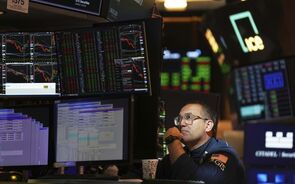States - What the TRIN is telling us (artigo)
4 mensagens
|Página 1 de 1
Este artigo fez-me lembrar um problema que se me deparou há uns tempos em relação à utilização do Arms Index, também conhecido por TRIN.
Num artigo de 15/03/2003, Alan Newman, editor do Longboat Global Advisors Crosscurrents, escrevia que durante muitos anos o TRIN (ver gráfico anexo) foi capaz de captar tops e bottoms através da medição de situações sobrecompradas e sobrevendidas. No entanto, nos últimos anos aquele indicador deixou de funcionar da mesma forma. Pelos seus estudos, essa situação estranha e fora do normal podia ser devida a um factor tão surpreendente como a decimalização das bolsas americanas que fez diminuir fortemente o número de títulos “sem variação”, de 25% para cerca de 5% do total (por exemplo, variações de 1/8 substituídas por variações de 1 cêntimo). Este facto, só por si, fez aumentar o TRIN, tal como se pode ver no gráfico.
Mas não é caso para rejeitar o TRIN, longe disso. Aliás o que estou a referir não põe em causa o que é referido no artigo.
No entanto, não deixo de referir que uma análise global do mercado, tal como é feita no artigo que o info nos trouxe, com base num único indicador, embora interessante é sempre falível. Mas não há dúvida que valores do TRIN acima de 2 são altíssimos…
Um abraço
Comentador
Num artigo de 15/03/2003, Alan Newman, editor do Longboat Global Advisors Crosscurrents, escrevia que durante muitos anos o TRIN (ver gráfico anexo) foi capaz de captar tops e bottoms através da medição de situações sobrecompradas e sobrevendidas. No entanto, nos últimos anos aquele indicador deixou de funcionar da mesma forma. Pelos seus estudos, essa situação estranha e fora do normal podia ser devida a um factor tão surpreendente como a decimalização das bolsas americanas que fez diminuir fortemente o número de títulos “sem variação”, de 25% para cerca de 5% do total (por exemplo, variações de 1/8 substituídas por variações de 1 cêntimo). Este facto, só por si, fez aumentar o TRIN, tal como se pode ver no gráfico.
Mas não é caso para rejeitar o TRIN, longe disso. Aliás o que estou a referir não põe em causa o que é referido no artigo.
No entanto, não deixo de referir que uma análise global do mercado, tal como é feita no artigo que o info nos trouxe, com base num único indicador, embora interessante é sempre falível. Mas não há dúvida que valores do TRIN acima de 2 são altíssimos…
Um abraço
Comentador
- Anexos
-
- Arms Index.png (3.85 KiB) Visualizado 226 vezes
- Mensagens: 378
- Registado: 26/4/2003 23:30
- Localização: 16
só para terem uma noção das proporções a q a coisa chegou a estar esta semana:
cheguei a ver o trin acima de 3! só num dia... nos outros ficou-se pelos 2.
este artigo tá mto fixe, em linha com o q o Mohan fala dos High Five, mas, como em tudo, isto é um indicador para se ser contrário, e só se pode usar a T.O.C. em extremos, pq aí funciona sempre. o prob é se n estivermos num extremo... pq aí n "acerta"
cheguei a ver o trin acima de 3! só num dia... nos outros ficou-se pelos 2.
este artigo tá mto fixe, em linha com o q o Mohan fala dos High Five, mas, como em tudo, isto é um indicador para se ser contrário, e só se pode usar a T.O.C. em extremos, pq aí funciona sempre. o prob é se n estivermos num extremo... pq aí n "acerta"
States - What the TRIN is telling us (artigo)
Signs of the TRIN - What the TRIN is telling us.
Are the high trading index readings bullish or dangerous?
By Mark Hulbert, CBS.MarketWatch.com
Last Update: 12:02 AM ET March 16, 2004
ANNANDALE, Va. (CBS.MW) -- Something happened last week in the stock market that hasn't been seen since Dwight Eisenhower was president.
The Trading Index -- or TRIN, for short -- was above 2.0 for three consecutive days.
This normally would be a very bullish development. But at least one newsletter editor I monitor thinks we are not living in normal times.
But I'm getting ahead of myself.
Let me first review what the TRIN is: It is technical indicator that was developed by Richard Arms in the late 1960s, and is sometimes also referred to as the Arms Index. It is calculated by taking the ratio of two numbers, each of which in turn is also a ratio:
- The numerator is the ratio of advancing issues to declining issues.
- The denominator is the ratio of the volume of advancing issues to the volume of declining issues.
For example, on Monday, there were 675 advancing issues on the NYSE and 2,160 decliners. So the numerator of this ratio would be 0.31 (675 divided by 2,160).
Furthermore, because advancing issues' volume on Monday was 190 million and declining issues' volume was 1.7 billion, the denominator of this ratio would be 0.11 (190 million divided by 1.7 billion).
Monday's TRIN reading for the NYSE therefore was 2.80, which is the ratio of 0.31 to 0.11.
As was the case on Monday, a TRIN reading above 1 means that there proportionately is more volume in declining issues than in the advancers. A reading below 1 would mean that volume is disproportionately concentrated among advancing issues.
High TRIN readings, even for just one day, are often considered evidence of panic selling on the part of investors. Since market bottoms often occur when investors throw in the towel, many interpret high TRIN readings as a bullish sign.
High TRIN readings for two consecutive days are even rarer and considered even more bullish.
And when such readings occur three days in a row? Well, that's capitulation.
In part of because of these high TRIN readings, James Stack of the InvesTech Market Analyst writes that we shouldn't "be alarmed by" the market's recent correction. Stack therefore has decided to keep his model portfolios nearly fully invested.
Peter Eliades, editor of Stockmarket Cycles, agrees with Stack that high TRIN readings normally would be a bullish indicator. But he has several problems with a bullish interpretation of the current situation.
First of all, Eliades stresses that there have been several major exceptions to the general rule that two consecutive high TRIN readings are bullish.
For example, he points out, after two consecutive TRIN readings above 2.50 in January 1941, "the Dow moved 5 percent lower over the next three weeks." Two such high back-to-back readings also occurred in August 1946, "and the Dow was 16 percent lower over the next nine weeks."
In other words, a bullish outcome in the current situation is by no means a certainty.
In addition, Eliades thinks it is ominous that the stock market has been unable to rally from last week's high TRIN readings. He interprets that to mean that there is "great instability in the market."
Conceding that he may come across as "overly dramatic," Eliades believes that, because of that instability, the odds of a market crash are now much higher than average.
"Readings such as we currently see on the Trading Index moving averages are usually signaling us that some kind of market bottom is imminent time wise. By that we mean we should see some type of bottom within the next two-three weeks, if not sooner. The tricky part of that equation is that it tells us nothing about the price vulnerability between now and that bottom. It could turn out to be very significant."
Are the high trading index readings bullish or dangerous?
By Mark Hulbert, CBS.MarketWatch.com
Last Update: 12:02 AM ET March 16, 2004
ANNANDALE, Va. (CBS.MW) -- Something happened last week in the stock market that hasn't been seen since Dwight Eisenhower was president.
The Trading Index -- or TRIN, for short -- was above 2.0 for three consecutive days.
This normally would be a very bullish development. But at least one newsletter editor I monitor thinks we are not living in normal times.
But I'm getting ahead of myself.
Let me first review what the TRIN is: It is technical indicator that was developed by Richard Arms in the late 1960s, and is sometimes also referred to as the Arms Index. It is calculated by taking the ratio of two numbers, each of which in turn is also a ratio:
- The numerator is the ratio of advancing issues to declining issues.
- The denominator is the ratio of the volume of advancing issues to the volume of declining issues.
For example, on Monday, there were 675 advancing issues on the NYSE and 2,160 decliners. So the numerator of this ratio would be 0.31 (675 divided by 2,160).
Furthermore, because advancing issues' volume on Monday was 190 million and declining issues' volume was 1.7 billion, the denominator of this ratio would be 0.11 (190 million divided by 1.7 billion).
Monday's TRIN reading for the NYSE therefore was 2.80, which is the ratio of 0.31 to 0.11.
As was the case on Monday, a TRIN reading above 1 means that there proportionately is more volume in declining issues than in the advancers. A reading below 1 would mean that volume is disproportionately concentrated among advancing issues.
High TRIN readings, even for just one day, are often considered evidence of panic selling on the part of investors. Since market bottoms often occur when investors throw in the towel, many interpret high TRIN readings as a bullish sign.
High TRIN readings for two consecutive days are even rarer and considered even more bullish.
And when such readings occur three days in a row? Well, that's capitulation.
In part of because of these high TRIN readings, James Stack of the InvesTech Market Analyst writes that we shouldn't "be alarmed by" the market's recent correction. Stack therefore has decided to keep his model portfolios nearly fully invested.
Peter Eliades, editor of Stockmarket Cycles, agrees with Stack that high TRIN readings normally would be a bullish indicator. But he has several problems with a bullish interpretation of the current situation.
First of all, Eliades stresses that there have been several major exceptions to the general rule that two consecutive high TRIN readings are bullish.
For example, he points out, after two consecutive TRIN readings above 2.50 in January 1941, "the Dow moved 5 percent lower over the next three weeks." Two such high back-to-back readings also occurred in August 1946, "and the Dow was 16 percent lower over the next nine weeks."
In other words, a bullish outcome in the current situation is by no means a certainty.
In addition, Eliades thinks it is ominous that the stock market has been unable to rally from last week's high TRIN readings. He interprets that to mean that there is "great instability in the market."
Conceding that he may come across as "overly dramatic," Eliades believes that, because of that instability, the odds of a market crash are now much higher than average.
"Readings such as we currently see on the Trading Index moving averages are usually signaling us that some kind of market bottom is imminent time wise. By that we mean we should see some type of bottom within the next two-three weeks, if not sooner. The tricky part of that equation is that it tells us nothing about the price vulnerability between now and that bottom. It could turn out to be very significant."
-
Info.
4 mensagens
|Página 1 de 1
Quem está ligado:



